Analysis of Causes and Effects of Opioid Use in Australia
VerifiedAdded on 2020/03/16
|6
|1515
|170
Essay
AI Summary
This essay delves into the causes and effects of the escalating use of prescription opioids in Australia. It highlights that the expanded use of opioids to treat chronic non-cancer pain and non-medical use by people who inject drugs are the primary causes. The essay then explores the detrimental effects, including a rise in opioid-related deaths, increased hospitalizations due to opioid poisoning, and a significant financial burden on the Australian government due to prescription subsidies. The essay also cites statistical data from the Australian Bureau of Statistics and other research to support its claims. The author recommends policy interventions such as patient and clinician education, and prescription drug monitoring programs to curb the misuse of opioids and reduce related harms.
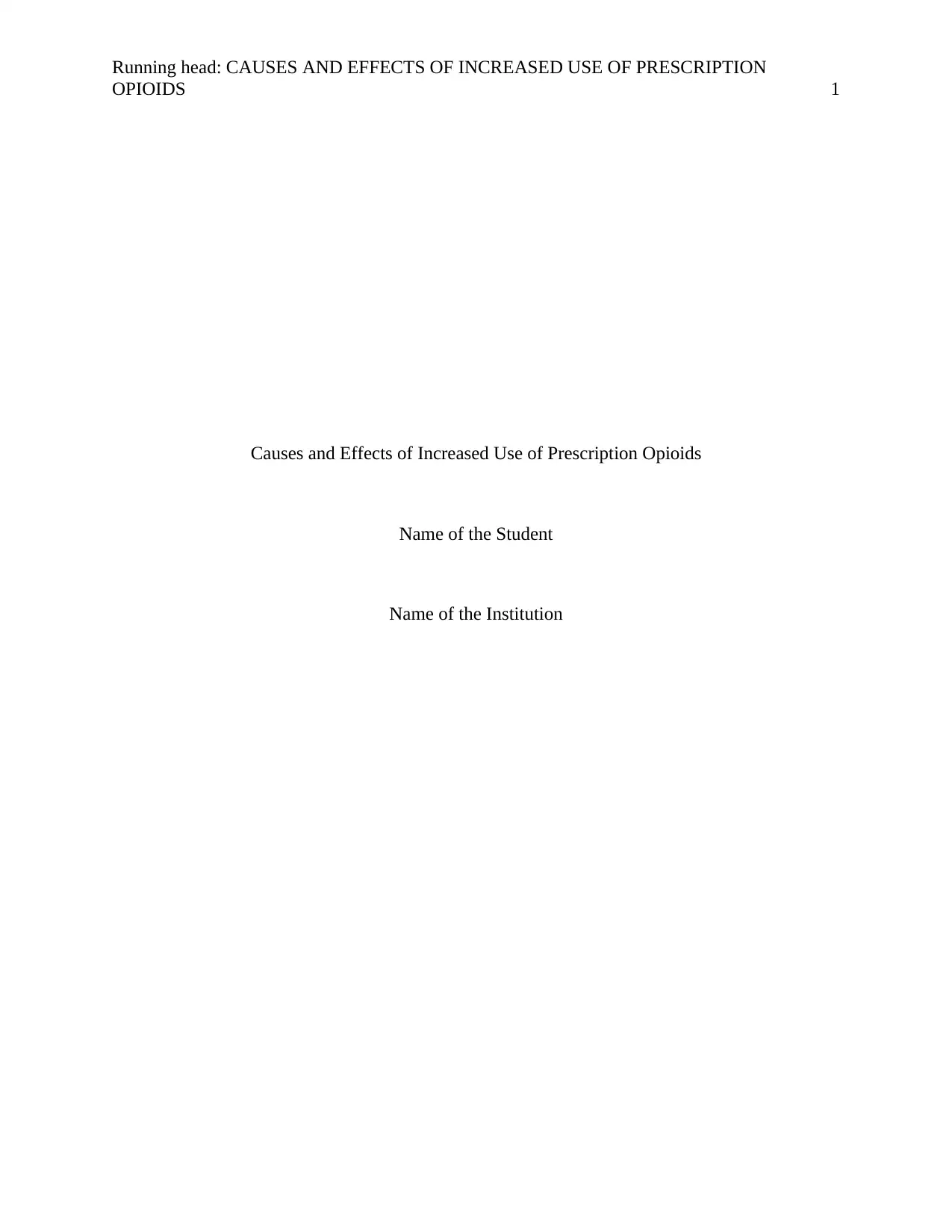
Running head: CAUSES AND EFFECTS OF INCREASED USE OF PRESCRIPTION
OPIOIDS 1
Causes and Effects of Increased Use of Prescription Opioids
Name of the Student
Name of the Institution
OPIOIDS 1
Causes and Effects of Increased Use of Prescription Opioids
Name of the Student
Name of the Institution
Paraphrase This Document
Need a fresh take? Get an instant paraphrase of this document with our AI Paraphraser
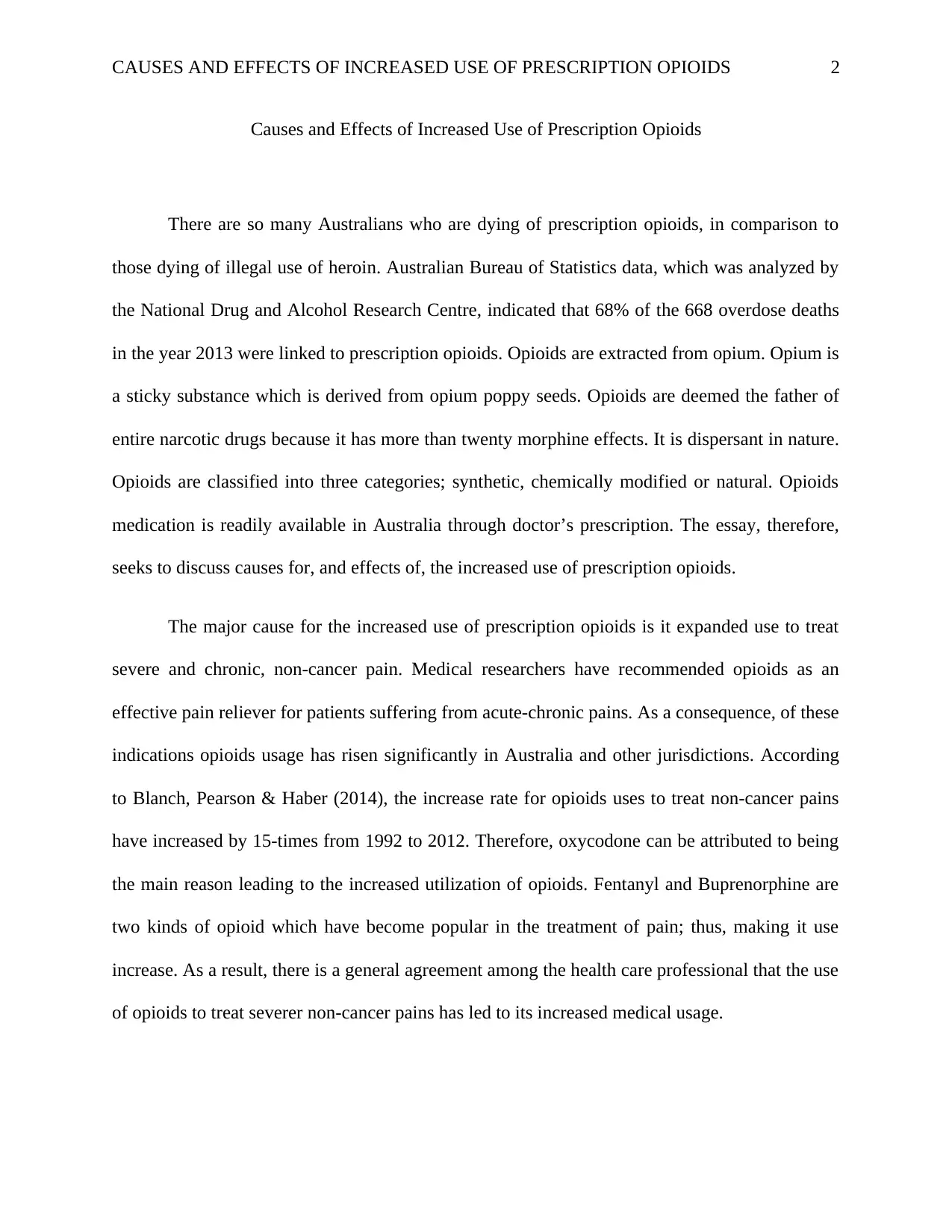
CAUSES AND EFFECTS OF INCREASED USE OF PRESCRIPTION OPIOIDS 2
Causes and Effects of Increased Use of Prescription Opioids
There are so many Australians who are dying of prescription opioids, in comparison to
those dying of illegal use of heroin. Australian Bureau of Statistics data, which was analyzed by
the National Drug and Alcohol Research Centre, indicated that 68% of the 668 overdose deaths
in the year 2013 were linked to prescription opioids. Opioids are extracted from opium. Opium is
a sticky substance which is derived from opium poppy seeds. Opioids are deemed the father of
entire narcotic drugs because it has more than twenty morphine effects. It is dispersant in nature.
Opioids are classified into three categories; synthetic, chemically modified or natural. Opioids
medication is readily available in Australia through doctor’s prescription. The essay, therefore,
seeks to discuss causes for, and effects of, the increased use of prescription opioids.
The major cause for the increased use of prescription opioids is it expanded use to treat
severe and chronic, non-cancer pain. Medical researchers have recommended opioids as an
effective pain reliever for patients suffering from acute-chronic pains. As a consequence, of these
indications opioids usage has risen significantly in Australia and other jurisdictions. According
to Blanch, Pearson & Haber (2014), the increase rate for opioids uses to treat non-cancer pains
have increased by 15-times from 1992 to 2012. Therefore, oxycodone can be attributed to being
the main reason leading to the increased utilization of opioids. Fentanyl and Buprenorphine are
two kinds of opioid which have become popular in the treatment of pain; thus, making it use
increase. As a result, there is a general agreement among the health care professional that the use
of opioids to treat severer non-cancer pains has led to its increased medical usage.
Causes and Effects of Increased Use of Prescription Opioids
There are so many Australians who are dying of prescription opioids, in comparison to
those dying of illegal use of heroin. Australian Bureau of Statistics data, which was analyzed by
the National Drug and Alcohol Research Centre, indicated that 68% of the 668 overdose deaths
in the year 2013 were linked to prescription opioids. Opioids are extracted from opium. Opium is
a sticky substance which is derived from opium poppy seeds. Opioids are deemed the father of
entire narcotic drugs because it has more than twenty morphine effects. It is dispersant in nature.
Opioids are classified into three categories; synthetic, chemically modified or natural. Opioids
medication is readily available in Australia through doctor’s prescription. The essay, therefore,
seeks to discuss causes for, and effects of, the increased use of prescription opioids.
The major cause for the increased use of prescription opioids is it expanded use to treat
severe and chronic, non-cancer pain. Medical researchers have recommended opioids as an
effective pain reliever for patients suffering from acute-chronic pains. As a consequence, of these
indications opioids usage has risen significantly in Australia and other jurisdictions. According
to Blanch, Pearson & Haber (2014), the increase rate for opioids uses to treat non-cancer pains
have increased by 15-times from 1992 to 2012. Therefore, oxycodone can be attributed to being
the main reason leading to the increased utilization of opioids. Fentanyl and Buprenorphine are
two kinds of opioid which have become popular in the treatment of pain; thus, making it use
increase. As a result, there is a general agreement among the health care professional that the use
of opioids to treat severer non-cancer pains has led to its increased medical usage.
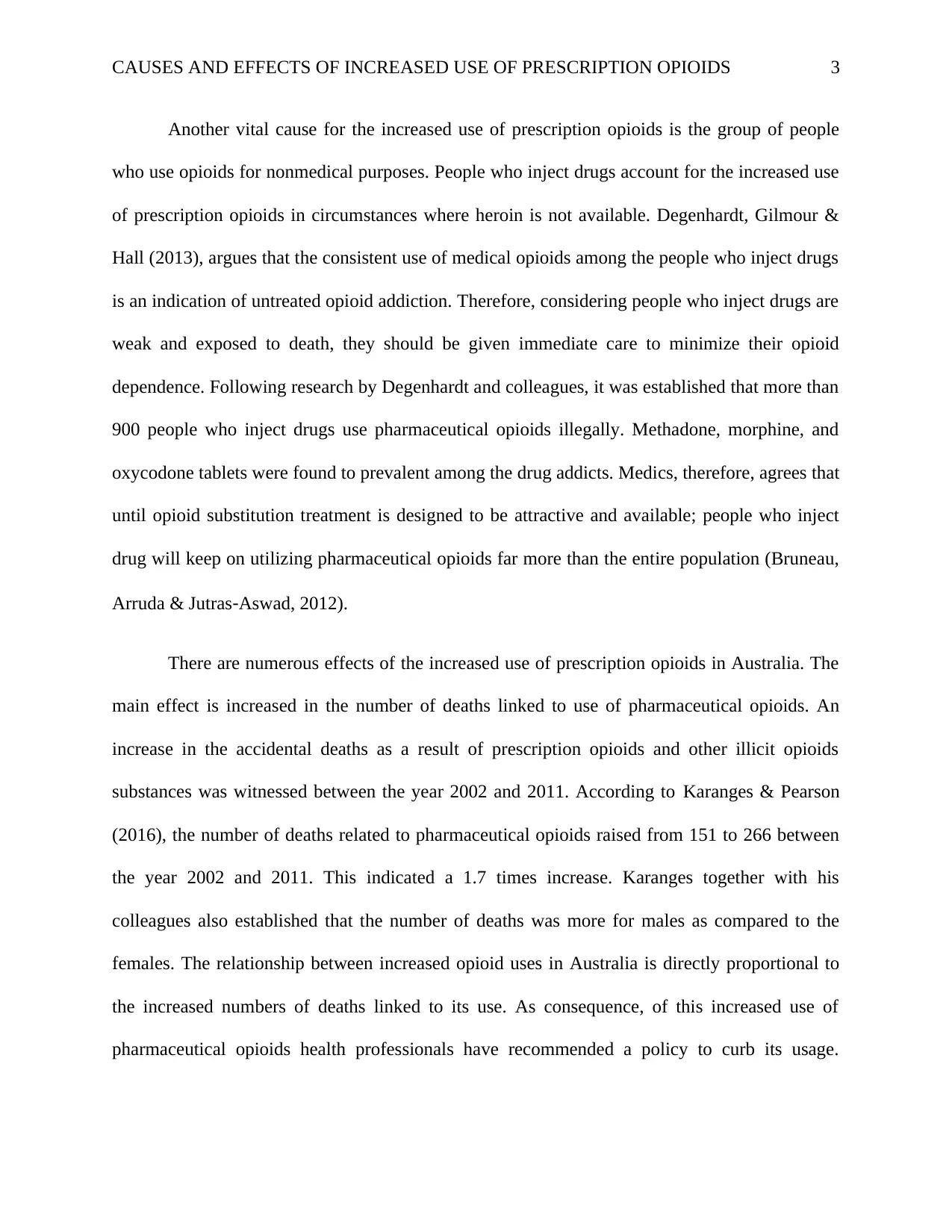
CAUSES AND EFFECTS OF INCREASED USE OF PRESCRIPTION OPIOIDS 3
Another vital cause for the increased use of prescription opioids is the group of people
who use opioids for nonmedical purposes. People who inject drugs account for the increased use
of prescription opioids in circumstances where heroin is not available. Degenhardt, Gilmour &
Hall (2013), argues that the consistent use of medical opioids among the people who inject drugs
is an indication of untreated opioid addiction. Therefore, considering people who inject drugs are
weak and exposed to death, they should be given immediate care to minimize their opioid
dependence. Following research by Degenhardt and colleagues, it was established that more than
900 people who inject drugs use pharmaceutical opioids illegally. Methadone, morphine, and
oxycodone tablets were found to prevalent among the drug addicts. Medics, therefore, agrees that
until opioid substitution treatment is designed to be attractive and available; people who inject
drug will keep on utilizing pharmaceutical opioids far more than the entire population (Bruneau,
Arruda & Jutras‐Aswad, 2012).
There are numerous effects of the increased use of prescription opioids in Australia. The
main effect is increased in the number of deaths linked to use of pharmaceutical opioids. An
increase in the accidental deaths as a result of prescription opioids and other illicit opioids
substances was witnessed between the year 2002 and 2011. According to Karanges & Pearson
(2016), the number of deaths related to pharmaceutical opioids raised from 151 to 266 between
the year 2002 and 2011. This indicated a 1.7 times increase. Karanges together with his
colleagues also established that the number of deaths was more for males as compared to the
females. The relationship between increased opioid uses in Australia is directly proportional to
the increased numbers of deaths linked to its use. As consequence, of this increased use of
pharmaceutical opioids health professionals have recommended a policy to curb its usage.
Another vital cause for the increased use of prescription opioids is the group of people
who use opioids for nonmedical purposes. People who inject drugs account for the increased use
of prescription opioids in circumstances where heroin is not available. Degenhardt, Gilmour &
Hall (2013), argues that the consistent use of medical opioids among the people who inject drugs
is an indication of untreated opioid addiction. Therefore, considering people who inject drugs are
weak and exposed to death, they should be given immediate care to minimize their opioid
dependence. Following research by Degenhardt and colleagues, it was established that more than
900 people who inject drugs use pharmaceutical opioids illegally. Methadone, morphine, and
oxycodone tablets were found to prevalent among the drug addicts. Medics, therefore, agrees that
until opioid substitution treatment is designed to be attractive and available; people who inject
drug will keep on utilizing pharmaceutical opioids far more than the entire population (Bruneau,
Arruda & Jutras‐Aswad, 2012).
There are numerous effects of the increased use of prescription opioids in Australia. The
main effect is increased in the number of deaths linked to use of pharmaceutical opioids. An
increase in the accidental deaths as a result of prescription opioids and other illicit opioids
substances was witnessed between the year 2002 and 2011. According to Karanges & Pearson
(2016), the number of deaths related to pharmaceutical opioids raised from 151 to 266 between
the year 2002 and 2011. This indicated a 1.7 times increase. Karanges together with his
colleagues also established that the number of deaths was more for males as compared to the
females. The relationship between increased opioid uses in Australia is directly proportional to
the increased numbers of deaths linked to its use. As consequence, of this increased use of
pharmaceutical opioids health professionals have recommended a policy to curb its usage.
⊘ This is a preview!⊘
Do you want full access?
Subscribe today to unlock all pages.

Trusted by 1+ million students worldwide
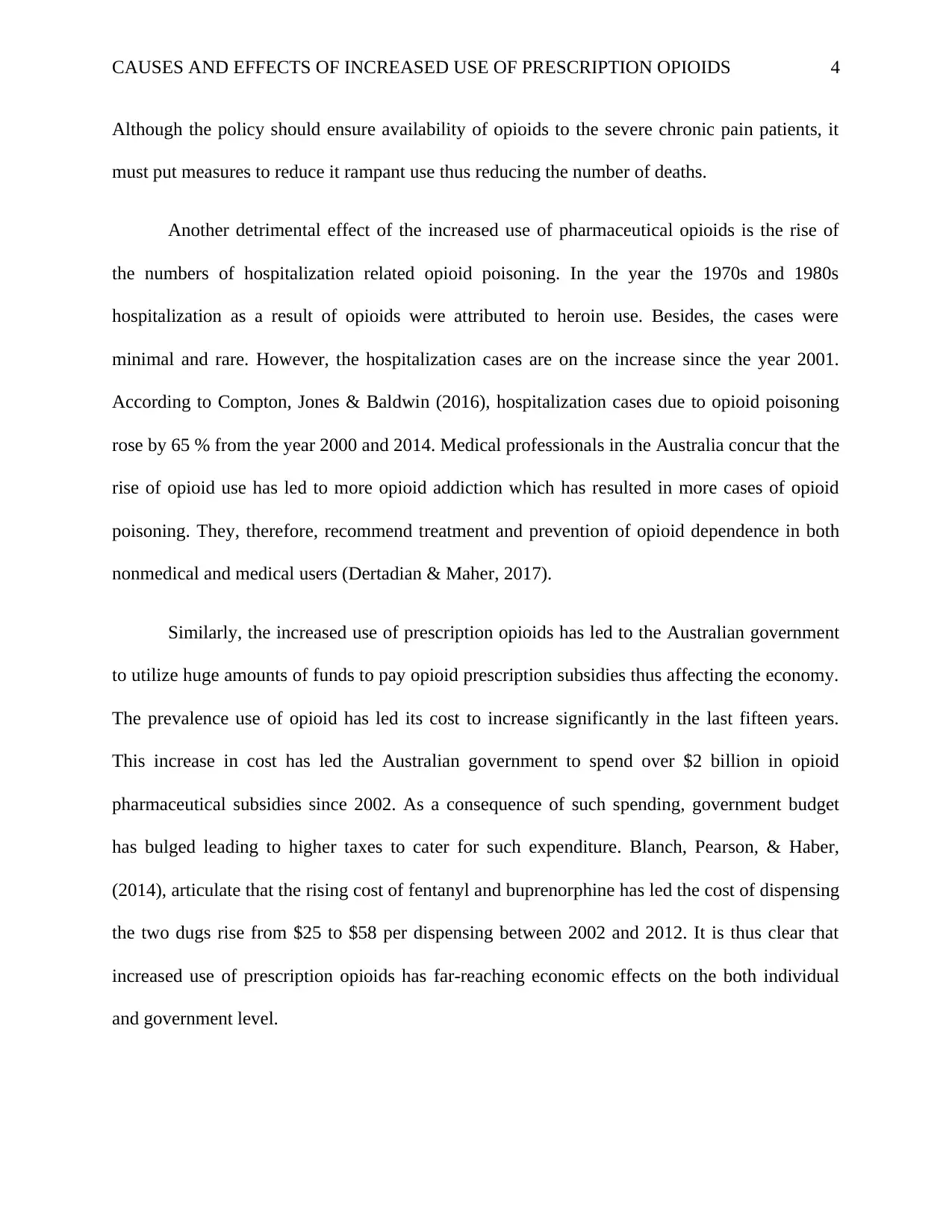
CAUSES AND EFFECTS OF INCREASED USE OF PRESCRIPTION OPIOIDS 4
Although the policy should ensure availability of opioids to the severe chronic pain patients, it
must put measures to reduce it rampant use thus reducing the number of deaths.
Another detrimental effect of the increased use of pharmaceutical opioids is the rise of
the numbers of hospitalization related opioid poisoning. In the year the 1970s and 1980s
hospitalization as a result of opioids were attributed to heroin use. Besides, the cases were
minimal and rare. However, the hospitalization cases are on the increase since the year 2001.
According to Compton, Jones & Baldwin (2016), hospitalization cases due to opioid poisoning
rose by 65 % from the year 2000 and 2014. Medical professionals in the Australia concur that the
rise of opioid use has led to more opioid addiction which has resulted in more cases of opioid
poisoning. They, therefore, recommend treatment and prevention of opioid dependence in both
nonmedical and medical users (Dertadian & Maher, 2017).
Similarly, the increased use of prescription opioids has led to the Australian government
to utilize huge amounts of funds to pay opioid prescription subsidies thus affecting the economy.
The prevalence use of opioid has led its cost to increase significantly in the last fifteen years.
This increase in cost has led the Australian government to spend over $2 billion in opioid
pharmaceutical subsidies since 2002. As a consequence of such spending, government budget
has bulged leading to higher taxes to cater for such expenditure. Blanch, Pearson, & Haber,
(2014), articulate that the rising cost of fentanyl and buprenorphine has led the cost of dispensing
the two dugs rise from $25 to $58 per dispensing between 2002 and 2012. It is thus clear that
increased use of prescription opioids has far-reaching economic effects on the both individual
and government level.
Although the policy should ensure availability of opioids to the severe chronic pain patients, it
must put measures to reduce it rampant use thus reducing the number of deaths.
Another detrimental effect of the increased use of pharmaceutical opioids is the rise of
the numbers of hospitalization related opioid poisoning. In the year the 1970s and 1980s
hospitalization as a result of opioids were attributed to heroin use. Besides, the cases were
minimal and rare. However, the hospitalization cases are on the increase since the year 2001.
According to Compton, Jones & Baldwin (2016), hospitalization cases due to opioid poisoning
rose by 65 % from the year 2000 and 2014. Medical professionals in the Australia concur that the
rise of opioid use has led to more opioid addiction which has resulted in more cases of opioid
poisoning. They, therefore, recommend treatment and prevention of opioid dependence in both
nonmedical and medical users (Dertadian & Maher, 2017).
Similarly, the increased use of prescription opioids has led to the Australian government
to utilize huge amounts of funds to pay opioid prescription subsidies thus affecting the economy.
The prevalence use of opioid has led its cost to increase significantly in the last fifteen years.
This increase in cost has led the Australian government to spend over $2 billion in opioid
pharmaceutical subsidies since 2002. As a consequence of such spending, government budget
has bulged leading to higher taxes to cater for such expenditure. Blanch, Pearson, & Haber,
(2014), articulate that the rising cost of fentanyl and buprenorphine has led the cost of dispensing
the two dugs rise from $25 to $58 per dispensing between 2002 and 2012. It is thus clear that
increased use of prescription opioids has far-reaching economic effects on the both individual
and government level.
Paraphrase This Document
Need a fresh take? Get an instant paraphrase of this document with our AI Paraphraser
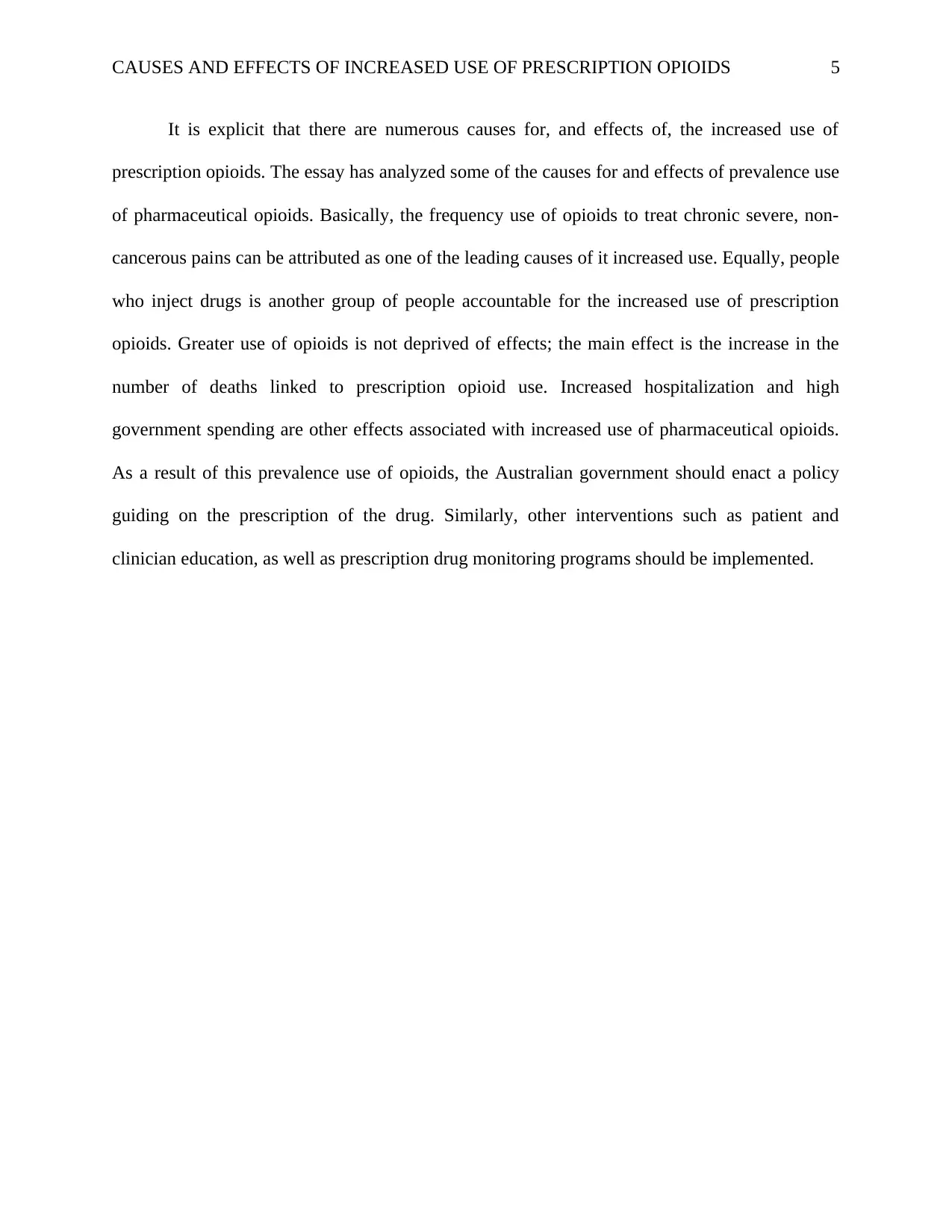
CAUSES AND EFFECTS OF INCREASED USE OF PRESCRIPTION OPIOIDS 5
It is explicit that there are numerous causes for, and effects of, the increased use of
prescription opioids. The essay has analyzed some of the causes for and effects of prevalence use
of pharmaceutical opioids. Basically, the frequency use of opioids to treat chronic severe, non-
cancerous pains can be attributed as one of the leading causes of it increased use. Equally, people
who inject drugs is another group of people accountable for the increased use of prescription
opioids. Greater use of opioids is not deprived of effects; the main effect is the increase in the
number of deaths linked to prescription opioid use. Increased hospitalization and high
government spending are other effects associated with increased use of pharmaceutical opioids.
As a result of this prevalence use of opioids, the Australian government should enact a policy
guiding on the prescription of the drug. Similarly, other interventions such as patient and
clinician education, as well as prescription drug monitoring programs should be implemented.
It is explicit that there are numerous causes for, and effects of, the increased use of
prescription opioids. The essay has analyzed some of the causes for and effects of prevalence use
of pharmaceutical opioids. Basically, the frequency use of opioids to treat chronic severe, non-
cancerous pains can be attributed as one of the leading causes of it increased use. Equally, people
who inject drugs is another group of people accountable for the increased use of prescription
opioids. Greater use of opioids is not deprived of effects; the main effect is the increase in the
number of deaths linked to prescription opioid use. Increased hospitalization and high
government spending are other effects associated with increased use of pharmaceutical opioids.
As a result of this prevalence use of opioids, the Australian government should enact a policy
guiding on the prescription of the drug. Similarly, other interventions such as patient and
clinician education, as well as prescription drug monitoring programs should be implemented.
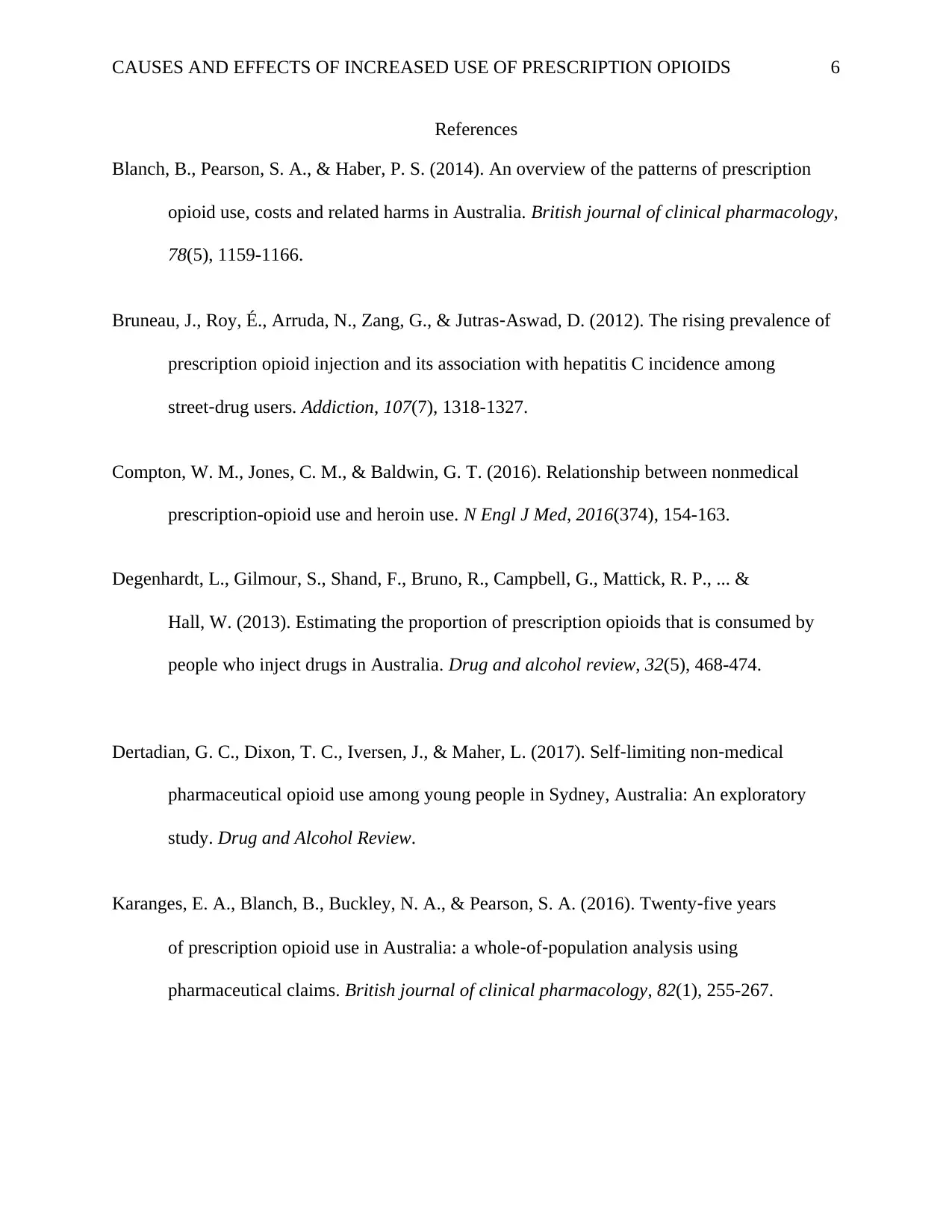
CAUSES AND EFFECTS OF INCREASED USE OF PRESCRIPTION OPIOIDS 6
References
Blanch, B., Pearson, S. A., & Haber, P. S. (2014). An overview of the patterns of prescription
opioid use, costs and related harms in Australia. British journal of clinical pharmacology,
78(5), 1159-1166.
Bruneau, J., Roy, É., Arruda, N., Zang, G., & Jutras‐Aswad, D. (2012). The rising prevalence of
prescription opioid injection and its association with hepatitis C incidence among
street‐drug users. Addiction, 107(7), 1318-1327.
Compton, W. M., Jones, C. M., & Baldwin, G. T. (2016). Relationship between nonmedical
prescription-opioid use and heroin use. N Engl J Med, 2016(374), 154-163.
Degenhardt, L., Gilmour, S., Shand, F., Bruno, R., Campbell, G., Mattick, R. P., ... &
Hall, W. (2013). Estimating the proportion of prescription opioids that is consumed by
people who inject drugs in Australia. Drug and alcohol review, 32(5), 468-474.
Dertadian, G. C., Dixon, T. C., Iversen, J., & Maher, L. (2017). Self‐limiting non‐medical
pharmaceutical opioid use among young people in Sydney, Australia: An exploratory
study. Drug and Alcohol Review.
Karanges, E. A., Blanch, B., Buckley, N. A., & Pearson, S. A. (2016). Twenty‐five years
of prescription opioid use in Australia: a whole‐of‐population analysis using
pharmaceutical claims. British journal of clinical pharmacology, 82(1), 255-267.
References
Blanch, B., Pearson, S. A., & Haber, P. S. (2014). An overview of the patterns of prescription
opioid use, costs and related harms in Australia. British journal of clinical pharmacology,
78(5), 1159-1166.
Bruneau, J., Roy, É., Arruda, N., Zang, G., & Jutras‐Aswad, D. (2012). The rising prevalence of
prescription opioid injection and its association with hepatitis C incidence among
street‐drug users. Addiction, 107(7), 1318-1327.
Compton, W. M., Jones, C. M., & Baldwin, G. T. (2016). Relationship between nonmedical
prescription-opioid use and heroin use. N Engl J Med, 2016(374), 154-163.
Degenhardt, L., Gilmour, S., Shand, F., Bruno, R., Campbell, G., Mattick, R. P., ... &
Hall, W. (2013). Estimating the proportion of prescription opioids that is consumed by
people who inject drugs in Australia. Drug and alcohol review, 32(5), 468-474.
Dertadian, G. C., Dixon, T. C., Iversen, J., & Maher, L. (2017). Self‐limiting non‐medical
pharmaceutical opioid use among young people in Sydney, Australia: An exploratory
study. Drug and Alcohol Review.
Karanges, E. A., Blanch, B., Buckley, N. A., & Pearson, S. A. (2016). Twenty‐five years
of prescription opioid use in Australia: a whole‐of‐population analysis using
pharmaceutical claims. British journal of clinical pharmacology, 82(1), 255-267.
⊘ This is a preview!⊘
Do you want full access?
Subscribe today to unlock all pages.

Trusted by 1+ million students worldwide
1 out of 6
Related Documents
Your All-in-One AI-Powered Toolkit for Academic Success.
+13062052269
info@desklib.com
Available 24*7 on WhatsApp / Email
![[object Object]](/_next/static/media/star-bottom.7253800d.svg)
Unlock your academic potential
Copyright © 2020–2025 A2Z Services. All Rights Reserved. Developed and managed by ZUCOL.





